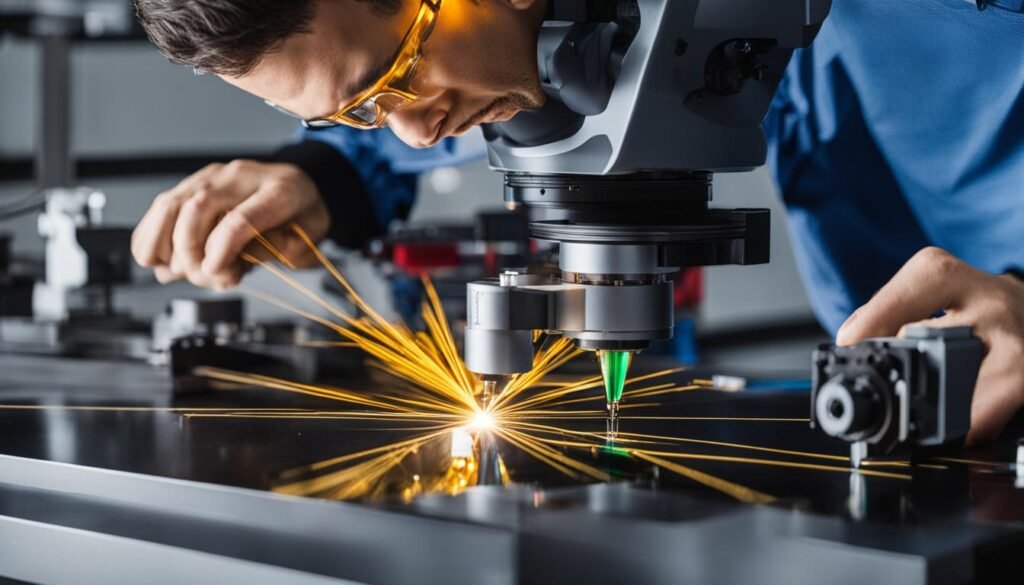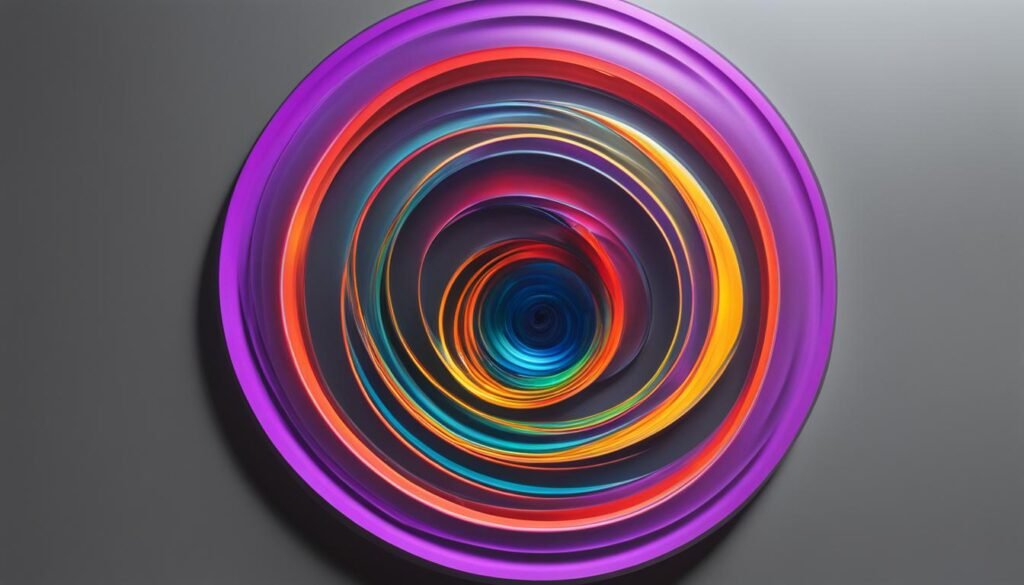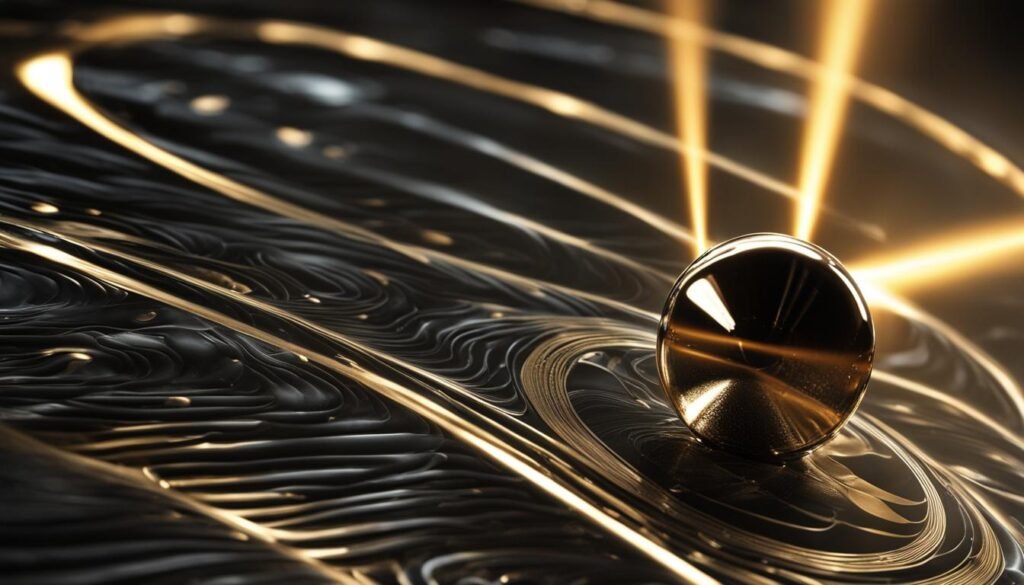Contents
- 1 Introduction to Direct-Write Techniques
- 2 Experimental Setup for LIFT Printing
- 3 Ejection Mechanisms in Laser-Induced Forward Transfer (LIFT)
- 4 Applications of Laser-induced Forward Transfer (LIFT)
- 5 Conclusion
- 6 FAQ
- 6.1 What is Laser-induced Forward Transfer (LIFT)?
- 6.2 When was LIFT first described?
- 6.3 What materials can be deposited using LIFT?
- 6.4 How does LIFT work?
- 6.5 What are the advantages of LIFT compared to traditional mass production methods?
- 6.6 What is the experimental setup for LIFT printing?
- 6.7 What are the ejection mechanisms in LIFT?
- 6.8 What are the applications of LIFT?
- 6.9 What is the future prospects of LIFT?
- 7 Source Links
Laser-induced forward transfer (LIFT) is a digital printing technique that allows for the precise transfer of materials from donor layers onto receiving substrates. LIFT was first described in 1968 and has since been used for the deposition of various materials, including metals, oxides, high-temperature superconductors, polymers, and biomolecules. The process involves utilizing a laser beam to generate a tiny vapor bubble, which then expels material from the donor layer onto the receiving substrate. LIFT offers customization possibilities, increased automatization, and decreased production costs compared to traditional mass production methods.
Key Takeaways:
- Laser-induced forward transfer (LIFT) is a digital printing technique for precise material transfer.
- LIFT utilizes a laser beam to generate a vapor bubble, ejecting material onto the receiving substrate.
- LIFT allows for customization, automatization, and cost reduction in production.
- Various materials, including metals, oxides, polymers, and biomolecules, can be transferred using LIFT.
- LIFT has applications in microfabrication and device fabrication, enabling the deposition of functional inks and complex patterns.
Introduction to Direct-Write Techniques
Direct-write techniques encompass a range of methods that allow for the precise creation of patterns and structures, offering increased customization and adaptability in mass production processes. Unlike traditional methods that rely on masks or molds, direct-write techniques enable the direct deposition of functional and/or structural materials onto a substrate in digitally defined locations.
Laser-induced forward transfer (LIFT) is one such direct-write technique that falls under this scope. LIFT is a digital printing technique that allows for the transfer of materials from donor layers onto receiving substrates with high precision. This technology offers numerous benefits over traditional manufacturing methods, including the ability to customize products, streamline production through automation, and reduce costs.
By harnessing the power of digitized printing, direct-write techniques like LIFT enable manufacturers to create intricate patterns and structures with ease. The ability to deposit materials precisely onto substrates opens up a world of possibilities in fields such as microfabrication and device fabrication. From the deposition of functional inks containing metals, polymers, and biomolecules to the fabrication of complex high-resolution patterns in three dimensions, LIFT offers exceptional speed and accuracy in the production of miniaturized devices.
With ongoing advancements in direct-write techniques like LIFT, the future looks promising for industries that require customization, precision, and efficiency in their manufacturing processes. These technologies have the potential to revolutionize the way products are made, allowing for greater flexibility and rapid prototyping while maintaining high levels of accuracy and reliability.
The Advantages of Direct-Write Techniques:
- Increased customization and adaptability in mass production
- Precise deposition of functional and/or structural materials
- Streamlined production through digitized printing
- Reduction in manufacturing costs
Experimental Setup for LIFT Printing

Laser Sources
The experimental setup for Laser-induced Forward Transfer (LIFT) printing involves the use of laser sources. These laser sources are typically pulsed laser systems that emit high-energy laser beams. The choice of laser source depends on various factors such as the desired wavelength, pulse duration, and power. Common types of lasers used for LIFT printing include Nd:YAG lasers, excimer lasers, and femtosecond lasers. The laser source plays a crucial role in determining the energy input and the resulting material ejection during the LIFT process.
Donor Substrate and Receiving Substrate
In LIFT printing, two substrates are essential: the donor substrate and the receiving substrate. The donor substrate is typically a transparent material that allows the laser beam to pass through it without significant absorption or scattering. This transparency is crucial to ensure efficient energy transfer from the laser to the donor layer. The receiving substrate, on the other hand, is the surface onto which the material is transferred during the LIFT process. It can be made of various materials, depending on the specific application. The choice of donor and receiving substrates depends on factors such as compatibility with the desired material to be transferred and the printing resolution requirements.
Laser Parameters
The laser parameters play a crucial role in controlling the LIFT printing process. These parameters include the laser fluence, pulse duration, repetition rate, and spot size. The laser fluence refers to the energy density of the laser beam and determines the amount of material transferred during each laser pulse. The pulse duration and repetition rate affect the speed and accuracy of the printing process. The spot size, or the size of the focused laser beam, determines the resolution and precision of the material deposition. Optimizing these laser parameters is essential to achieve the desired material transfer and printing quality in LIFT.
| Laser Parameters | Description |
|---|---|
| Laser Fluence | The energy density of the laser beam |
| Pulse Duration | The duration of each laser pulse |
| Repetition Rate | The frequency of laser pulse emission |
| Spot Size | The size of the focused laser beam |
By carefully choosing and optimizing these laser parameters, researchers and engineers can achieve precise and controlled LIFT printing, enabling applications in various fields such as microfabrication, device fabrication, and functional material deposition.
“The experimental setup for LIFT printing involves the use of laser sources, donor substrates, and receiving substrates. Laser parameters such as fluence, pulse duration, repetition rate, and spot size play a crucial role in controlling the printing process.” – Researcher
Ejection Mechanisms in Laser-Induced Forward Transfer (LIFT)

Laser-induced forward transfer (LIFT) involves complex ejection mechanisms that facilitate material transfer from the donor layer to the receiving substrate. Understanding these ejection dynamics is crucial for optimizing the printing process and achieving precise pattern deposition.
During LIFT, a laser beam generates a vapor bubble at the interface between the donor substrate and the donor layer. As the bubble expands, it exerts pressure on the liquid ink, causing it to flow towards the pole of the bubble. This pressure gradient leads to the ejection of two jets—one propagates forward towards the receiving substrate, depositing the material, while the other moves backward into the donor substrate.
The jetting dynamics in LIFT resemble the behavior of an expanding bubble near a free liquid surface. The ejection of the material occurs due to the high-pressure release, which propels the jets forward. The velocity and direction of the jets depend on various factors, including the laser parameters, ink properties, and substrate characteristics. By controlling these factors, researchers can manipulate the ejection mechanisms to achieve specific printing outcomes.
Ejection Mechanisms in LIFT: Key Factors and Considerations
Several factors influence the ejection mechanisms in LIFT, including:
- Laser parameters: The choice of laser source, wavelength, pulse duration, and fluence significantly impact the bubble formation and subsequent ejection dynamics.
- Material properties: The physical and chemical properties of the ink or material being transferred play a crucial role in determining the ejection behavior. Viscosity, surface tension, and rheological properties affect the flow and jet formation.
- Substrate characteristics: The properties of the receiving substrate, such as its surface roughness, wettability, and thermal conductivity, affect the interaction between the ejected material and the substrate.
Understanding and optimizing these factors can help researchers achieve precise material transfer with desired resolution and efficiency in LIFT printing.
Summary
LIFT printing relies on intricate ejection mechanisms to transfer materials from the donor to the receiving substrate. The generation of a vapor bubble leads to the ejection of material in the form of forward-propagating jets. By controlling laser parameters, material properties, and substrate characteristics, researchers can manipulate these ejection dynamics to achieve precise and customizable printing outcomes. Optimizing these factors is crucial for enhancing the efficiency and resolution of LIFT printing in various applications.
Applications of Laser-induced Forward Transfer (LIFT)
Laser-induced forward transfer (LIFT) has proven to be a versatile technology with numerous applications in microfabrication and device fabrication. Through the precise deposition of functional inks containing metals, oxides, polymers, and biomolecules, LIFT enables the fabrication of complex high-resolution patterns in three dimensions. This enables the creation of miniaturized devices such as microchannels, grooves, and well arrays, as well as the deposition of sensitive and functional materials. The capabilities of LIFT make it a valuable tool in diverse industries.
LIFT’s ability to transfer functional inks onto receiving substrates with high speed and accuracy has opened up new avenues in microfabrication. The technology allows for the production of intricate structures and patterns, enabling the development of advanced microdevices with enhanced functionality. Whether it’s creating microfluidic channels for biomedical applications, intricate electrodes for sensors, or precise patterns for electronic devices, LIFT offers a level of customization and precision that traditional manufacturing methods struggle to match.
In the field of device fabrication, LIFT has been utilized to deposit various materials onto substrates, paving the way for the development of advanced electronic and optoelectronic devices. By leveraging LIFT’s ability to deposit multiple materials with high precision, researchers and engineers have been able to create devices with complex architectures and tailored properties. The deposition of functional inks containing semiconducting, dielectric, and conductive materials enables the fabrication of transistors, sensors, and other electronic components with high performance and reliability.
In summary, the applications of Laser-induced forward transfer (LIFT) are far-reaching and impactful. Its ability to deposit functional inks and create precise patterns enables advancements in microfabrication and device fabrication. With ongoing research and development, LIFT is expected to continue playing a crucial role in various industries, driving innovation and pushing the boundaries of what is possible in manufacturing and device design.
Conclusion
In conclusion, Laser-induced forward transfer (LIFT) is a transformative technology that enables precise material transfer through digital printing techniques. LIFT offers easy customization, increased automatization, and reduced production costs compared to traditional mass production methods.
The experimental setup for LIFT printing involves a laser beam, donor substrates, and receiving substrates, with various laser parameters to control the printing process. The ejection mechanisms in LIFT involve the generation and expansion of a vapor bubble, resulting in the ejection of material through jetting dynamics.
LIFT has found applications in microfabrication and device fabrication, allowing for the deposition of functional inks and the fabrication of complex patterns. With ongoing advancements in LIFT technology, there are promising prospects for its future applications in various industries.
Future Prospects
Looking ahead, the future of LIFT appears bright. As researchers continue to investigate and refine the underlying mechanisms of material transfer, we can expect further improvements in printing precision and efficiency. Additionally, the versatility of LIFT opens up possibilities for new applications in fields such as electronics, biomedical engineering, and optics.
Moreover, the potential integration of LIFT with other additive manufacturing techniques could unlock even more opportunities for advanced fabrication processes. By combining LIFT with technologies such as 3D printing or inkjet printing, we could achieve complex multi-material structures and functional devices with enhanced performance.
Overall, LIFT has demonstrated its capability as a versatile and reliable digital printing technique for material transfer. As we continue to explore its potential, we eagerly anticipate the exciting developments and innovations that will shape the future of LIFT and its impact on various industries.
FAQ
What is Laser-induced Forward Transfer (LIFT)?
Laser-induced forward transfer (LIFT) is a digital printing technique that allows for the precise transfer of materials from donor layers onto receiving substrates.
When was LIFT first described?
LIFT was first described in 1968.
What materials can be deposited using LIFT?
LIFT has been used for the deposition of various materials, including metals, oxides, high-temperature superconductors, polymers, and biomolecules.
How does LIFT work?
LIFT involves utilizing a laser beam to generate a tiny vapor bubble, which then expels material from the donor layer onto the receiving substrate.
What are the advantages of LIFT compared to traditional mass production methods?
LIFT offers customization possibilities, increased automatization, and decreased production costs compared to traditional mass production methods.
What is the experimental setup for LIFT printing?
The experimental setup for LIFT printing involves a laser beam, donor substrates, and receiving substrates, with various laser parameters to control the printing process.
What are the ejection mechanisms in LIFT?
The ejection mechanisms in LIFT involve the generation and expansion of a vapor bubble, resulting in the ejection of material through jetting dynamics.
What are the applications of LIFT?
LIFT has found applications in microfabrication and device fabrication, allowing for the deposition of functional inks and the fabrication of complex patterns.
What is the future prospects of LIFT?
With ongoing advancements in LIFT technology, there are promising prospects for its future applications in various industries.



